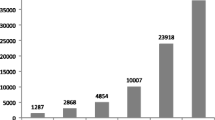Summary
We have analyzed the sequence of 63 B1 and 71 B2 repetitive elements from published data base sequences. The sequences conform to previously published consensus sequences, but are not identical to them. The B2 sequences show seven regions of high variability between family members, which we show points to the B2 family containing subfamilies; no similar evidence is found for subfamilies of the B1 family. The comparisons show no evidence for the emergence of species-specific variants of B1 or B2 sequences since the separation of murine and hamster lines of descent, nor of their concerted evolution within species in the last 10 million years.
Similar content being viewed by others
References
Bains W (1986a) MULTAN: a program to align multiple DNA sequences. Nucleic Acids Res 14:159–177
Bains W (1986b) The multiple origins of human Alu sequences. J Mol Evol 23:189–199
Bains W, Bains J (1987) Rate of base substitution in mammalian nuclear DNA is dependent on local sequence context. Mutat Res 179:65–74
Bilofsky HS, Burks C, Fickett JW, Goad WB, Lewitter FI, Waync PR, Swindell CD, Tung C-S (1986) The Genbank genetic sequence database. Nucleic Acids Res 14:1–4
Daniels GR, Deininger PL (1985) Integration site preferences of the Alu family and similar repetitive sequences. Nucleic Acids Res 13:8939–8954
Davidson EH, Graham DE, Neufeld BR, Chamberlin ME, Amenson CS, Hough BR, Britten RJ (1973) Arrangement and characterisation of repetitive sequence elements in animal DNAs. Cold Spring Harbor Symp Quant Biol 38:295–301
Deininger PL, Daniels GR (1986) The recent evolution of mammalian repetitive DNA elements. Trends Genet March: 76–80
Dover GA (1982) Molecular drive: a cohesive mode of species evolution. Nature 299:111–117
Farris (1972) Estimating phylogenetic trees from distance matrices. Am Nat 106:645–668
Hamm GH, Cameron GN (1986) The EMBL data library. Nucleic Acids Res 14:5–9
Jeffreys AJ, Wilson V, Thein SL (1985) Hypervariable “minisatellite” regions in human DNA. Nature 314:67–73
Kalb VF, Glasser S, King D, Lingrel JB (1983) A cluster of repetitive elements within a 700 base pair region in the mouse genome. Nucleic Acids Res 11:2177–2184
Ohta T, Dover GA (1983) Population genetics of multigene families that are dispersed into two or more chromosomes. Proc Natl Acad Sci USA 80:4079–4083
Ohta T, Dover GA (1984) The cohesive population genetics of molecular drive. Genetics 108:501–521
Rogers J (1985) Retroposons. Int Rev Cytol 93:187–279
Schmid CW, Shen C-KJ (1985) The evolution of interspersed repetitive DNA sequences in mammals and other vertebrates. In: MacIntyre RJ (ed) Molecular evolutionary genetics. Plenum, Oxford, pp 323–358
Tajima F (1983) Evolutionary relationships of DNA sequences in finite populations. Genetics 105:437–460
Author information
Authors and Affiliations
Rights and permissions
About this article
Cite this article
Bains, W., Temple-Smith, K. Similarity and divergence among rodent repetitive DNA sequences. J Mol Evol 28, 191–199 (1989). https://doi.org/10.1007/BF02102476
Received:
Revised:
Issue Date:
DOI: https://doi.org/10.1007/BF02102476



